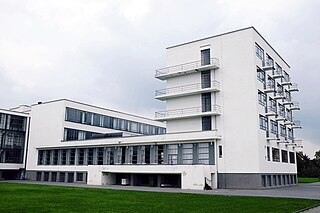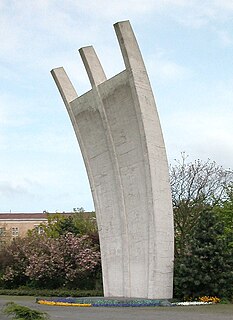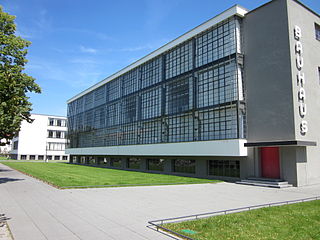
The Staatliches Bauhaus, commonly known as the Bauhaus, was a German art school operational from 1919 to 1933 that combined crafts and the fine arts. The school became famous for its approach to design, which attempted to unify the principles of mass production with individual artistic vision and strove to combine aesthetics with everyday function.

Ludwig Mies van der Rohe was a German-American architect. He was commonly referred to as Mies, his surname. Along with Alvar Aalto, Le Corbusier, Walter Gropius and Frank Lloyd Wright, he is regarded as one of the pioneers of modernist architecture.

Walter Adolph Georg Gropius was a German-American architect and founder of the Bauhaus School, who, along with Alvar Aalto, Ludwig Mies van der Rohe, Le Corbusier and Frank Lloyd Wright, is widely regarded as one of the pioneering masters of modernist architecture. He is a founder of Bauhaus in Weimar (1919). Gropius was also a leading architect of the International Style.

The International Style or internationalism is a major architectural style that was developed in the 1920s and 1930s and was closely related to modernism and modernist architecture. It was first defined by Museum of Modern Art curators Henry-Russell Hitchcock and Philip Johnson in 1932, based on works of architecture from the 1920s. The terms rationalist architecture and modern movement are often used interchangeably with International Style, although the former is mostly used in the English-speaking world to specifically refer to the Italian rationalism, or even the International Style that developed in Europe as a whole.

Modern architecture, or modernist architecture, was an architectural movement or architectural style based upon new and innovative technologies of construction, particularly the use of glass, steel, and reinforced concrete; the idea that form should follow function (functionalism); an embrace of minimalism; and a rejection of ornament. It emerged in the first half of the 20th century and became dominant after World War II until the 1980s, when it was gradually replaced as the principal style for institutional and corporate buildings by postmodern architecture.
This is a timeline of architecture, indexing the individual year in architecture pages. Notable events in architecture and related disciplines including structural engineering, landscape architecture, and city planning. One significant architectural achievement is listed for each year.
The year 1958 in architecture involved some significant architectural events and new buildings.
The year 2001 in architecture involved some significant architectural events and new buildings.
The year 1963 in architecture involved some significant architectural events and new buildings.
The year 1968 in architecture involved some significant architectural events and new buildings.
The year 2005 in architecture involved some significant architectural events and new buildings.
The year 1975 in architecture involved some significant architectural events and new buildings.
Ludwig Karl Hilberseimer was a German architect and urban planner best known for his ties to the Bauhaus and to Mies van der Rohe, as well as for his work in urban planning at Armour Institute of Technology, in Chicago, Illinois.

Bertrand Goldberg was an American architect and industrial designer, best known for the Marina City complex in Chicago, Illinois, the tallest reinforced concrete building in the world at the time of completion.

Hermann Henselmann was a German architect most famous for his buildings constructed in East Germany during the 1950s and 1960s.

The architecture of Germany has a long, rich and diverse history. Every major European style from Roman to Postmodern is represented, including renowned examples of Carolingian, Romanesque, Gothic, Renaissance, Baroque, Classical, Modern and International Style architecture.

The New Objectivity is a name often given to the Modern architecture that emerged in Europe, primarily German-speaking Europe, in the 1920s and 30s. It is also frequently called Neues Bauen. The New Objectivity remodeled many German cities in this period.

Eduard Ludwig was a German architect. He was a student at the Bauhaus design school and later worked with notable architects from the school. He designed the Berlin Airlift Monument in Platz der Luftbrücke, Berlin.

Bauhaus and its Sites in Weimar, Dessau and Bernau is a World Heritage Site in Germany, comprising six separate sites which are associated with the Bauhaus art school. It was designated in 1996 with four initial sites, and in 2017 two further sites were added.
Selman Selmanagić was a Bosnian-German architect and long-time professor at the Weißensee Academy of Art Berlin who worked extensively for the government of East Germany.













